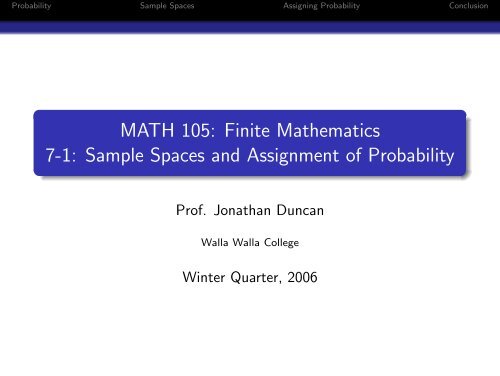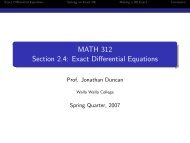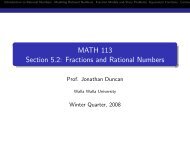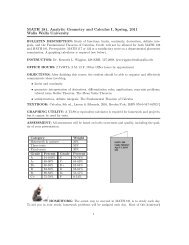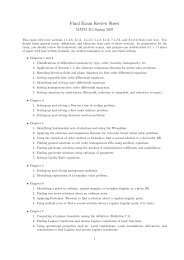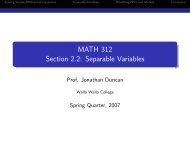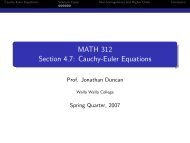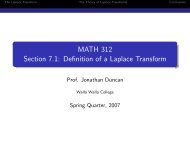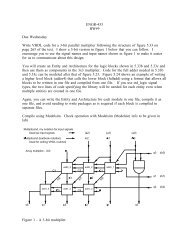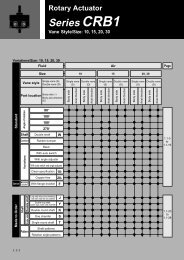Sample Spaces and Assignment of Probability
Sample Spaces and Assignment of Probability
Sample Spaces and Assignment of Probability
You also want an ePaper? Increase the reach of your titles
YUMPU automatically turns print PDFs into web optimized ePapers that Google loves.
<strong>Probability</strong> <strong>Sample</strong> <strong>Spaces</strong> Assigning <strong>Probability</strong> ConclusionMATH 105: Finite Mathematics7-1: <strong>Sample</strong> <strong>Spaces</strong> <strong>and</strong> <strong>Assignment</strong> <strong>of</strong> <strong>Probability</strong>Pr<strong>of</strong>. Jonathan DuncanWalla Walla CollegeWinter Quarter, 2006
<strong>Probability</strong> <strong>Sample</strong> <strong>Spaces</strong> Assigning <strong>Probability</strong> ConclusionOutline1 <strong>Probability</strong>2 <strong>Sample</strong> <strong>Spaces</strong>3 Assigning <strong>Probability</strong>4 Conclusion
<strong>Probability</strong> <strong>Sample</strong> <strong>Spaces</strong> Assigning <strong>Probability</strong> ConclusionOutline1 <strong>Probability</strong>2 <strong>Sample</strong> <strong>Spaces</strong>3 Assigning <strong>Probability</strong>4 Conclusion
<strong>Probability</strong> <strong>Sample</strong> <strong>Spaces</strong> Assigning <strong>Probability</strong> ConclusionIntroduction to <strong>Probability</strong>Many real world events can be considered chance or r<strong>and</strong>om. Theymay be deterministic, but we can not know or comprehend all thefactors which determine the outcome.ExampleYou flip a coin. Air current, the arrangement <strong>of</strong> the coin on yourfinger, the force <strong>of</strong> your flip, <strong>and</strong> other factors all go together todetermine the outcome <strong>of</strong> Heads or Tails.For any one toss, these factors are too complicated to take intoaccount, <strong>and</strong> the outcome appears r<strong>and</strong>om. Since the outcome isheads roughly half the time, we assign the following probabilities:Pr[H] = 1 2Pr[T ] = 1 2
<strong>Probability</strong> <strong>Sample</strong> <strong>Spaces</strong> Assigning <strong>Probability</strong> ConclusionIntroduction to <strong>Probability</strong>Many real world events can be considered chance or r<strong>and</strong>om. Theymay be deterministic, but we can not know or comprehend all thefactors which determine the outcome.ExampleYou flip a coin. Air current, the arrangement <strong>of</strong> the coin on yourfinger, the force <strong>of</strong> your flip, <strong>and</strong> other factors all go together todetermine the outcome <strong>of</strong> Heads or Tails.For any one toss, these factors are too complicated to take intoaccount, <strong>and</strong> the outcome appears r<strong>and</strong>om. Since the outcome isheads roughly half the time, we assign the following probabilities:Pr[H] = 1 2Pr[T ] = 1 2
<strong>Probability</strong> <strong>Sample</strong> <strong>Spaces</strong> Assigning <strong>Probability</strong> Conclusion<strong>Probability</strong> Vocabulary<strong>Probability</strong> TermsOutcomeA particular result <strong>of</strong> an activity or event.EventA set <strong>of</strong> outcomes which share a common characteristic.<strong>Sample</strong> SpaceThe set <strong>of</strong> all possible outcomes for an experiment. This isthe universal set for the experiment.Equally Likely EventsAll events in the sample space have the same probability.
<strong>Probability</strong> <strong>Sample</strong> <strong>Spaces</strong> Assigning <strong>Probability</strong> Conclusion<strong>Probability</strong> Vocabulary<strong>Probability</strong> TermsOutcomeA particular result <strong>of</strong> an activity or event.EventA set <strong>of</strong> outcomes which share a common characteristic.<strong>Sample</strong> SpaceThe set <strong>of</strong> all possible outcomes for an experiment. This isthe universal set for the experiment.Equally Likely EventsAll events in the sample space have the same probability.
Crisis económica y social (2001-2002)• Fuerte retroceso de la dem<strong>and</strong>a en 2001 y2002.• Congelamiento de tarifas como medidade emergencia social.• Decreto de emergencia ferroviaria. Atenuóexigencias de los contratos (cantidad ycalidad de los servicios, mantenimiento).• Gradual aumento de los costos.• Subsidios retoman el crecimiento.• Muy pocas inversiones.
<strong>Probability</strong> <strong>Sample</strong> <strong>Spaces</strong> Assigning <strong>Probability</strong> ConclusionFinding <strong>Sample</strong> <strong>Spaces</strong>One <strong>of</strong> the first tasks in finding probability is to determine thesample space for the experiment.ExampleYou flip a fair coin. What is the sample space for this experiment?ExampleYou roll a six-sided die <strong>and</strong> note the number which appears on top.What is the sample space for this experiment?
<strong>Probability</strong> <strong>Sample</strong> <strong>Spaces</strong> Assigning <strong>Probability</strong> ConclusionFinding <strong>Sample</strong> <strong>Spaces</strong>One <strong>of</strong> the first tasks in finding probability is to determine thesample space for the experiment.ExampleYou flip a fair coin. What is the sample space for this experiment?S = {H, T }ExampleYou roll a six-sided die <strong>and</strong> note the number which appears on top.What is the sample space for this experiment?S = {1, 2, 3, 4, 5, 6}
<strong>Probability</strong> <strong>Sample</strong> <strong>Spaces</strong> Assigning <strong>Probability</strong> ConclusionFinding More <strong>Sample</strong> <strong>Spaces</strong>ExampleYou flip a coin <strong>and</strong> roll a die, <strong>and</strong> note the result <strong>of</strong> each. what isthe sample space for this experiment?S = {H1, H2, . . ., H6, T 1, T 2, . . ., T 6}c(S) = 2 · 6 = 12
<strong>Probability</strong> <strong>Sample</strong> <strong>Spaces</strong> Assigning <strong>Probability</strong> ConclusionFinding More <strong>Sample</strong> <strong>Spaces</strong>ExampleYou flip a coin <strong>and</strong> roll a die, <strong>and</strong> note the result <strong>of</strong> each. what isthe sample space for this experiment?S = {H1, H2, . . ., H6, T 1, T 2, . . ., T 6}c(S) = 2 · 6 = 12
<strong>Probability</strong> <strong>Sample</strong> <strong>Spaces</strong> Assigning <strong>Probability</strong> ConclusionFinding More <strong>Sample</strong> <strong>Spaces</strong>ExampleYou flip a coin <strong>and</strong> roll a die, <strong>and</strong> note the result <strong>of</strong> each. what isthe sample space for this experiment?S = {H1, H2, . . ., H6, T 1, T 2, . . ., T 6}c(S) = 2 · 6 = 12
<strong>Probability</strong> <strong>Sample</strong> <strong>Spaces</strong> Assigning <strong>Probability</strong> ConclusionDifferent <strong>Sample</strong> <strong>Spaces</strong> for the Same ExperimentExampleYou roll two dice <strong>and</strong> note both numbers. What is the samplespace for this experiment?ExampleYou roll two dice <strong>and</strong> note the sum <strong>of</strong> the two numbers. What isthe sample space for this experiment?
<strong>Probability</strong> <strong>Sample</strong> <strong>Spaces</strong> Assigning <strong>Probability</strong> ConclusionDifferent <strong>Sample</strong> <strong>Spaces</strong> for the Same ExperimentExampleYou roll two dice <strong>and</strong> note both numbers. What is the samplespace for this experiment?S = {(1, 1), (1, 2), . . ., (2, 1), (2, 2), . . .} c(S) = 6 · 6 = 36ExampleYou roll two dice <strong>and</strong> note the sum <strong>of</strong> the two numbers. What isthe sample space for this experiment?
<strong>Probability</strong> <strong>Sample</strong> <strong>Spaces</strong> Assigning <strong>Probability</strong> ConclusionDifferent <strong>Sample</strong> <strong>Spaces</strong> for the Same ExperimentExampleYou roll two dice <strong>and</strong> note both numbers. What is the samplespace for this experiment?S = {(1, 1), (1, 2), . . ., (2, 1), (2, 2), . . .} c(S) = 6 · 6 = 36ExampleYou roll two dice <strong>and</strong> note the sum <strong>of</strong> the two numbers. What isthe sample space for this experiment?
<strong>Probability</strong> <strong>Sample</strong> <strong>Spaces</strong> Assigning <strong>Probability</strong> ConclusionDifferent <strong>Sample</strong> <strong>Spaces</strong> for the Same ExperimentExampleYou roll two dice <strong>and</strong> note both numbers. What is the samplespace for this experiment?S = {(1, 1), (1, 2), . . ., (2, 1), (2, 2), . . .} c(S) = 6 · 6 = 36ExampleYou roll two dice <strong>and</strong> note the sum <strong>of</strong> the two numbers. What isthe sample space for this experiment?S = {2, 3, . . ., 12} c(S) = 11
<strong>Probability</strong> <strong>Sample</strong> <strong>Spaces</strong> Assigning <strong>Probability</strong> ConclusionTaking a QuizExampleYou take a True/False quiz with three questions. If you treat thisquiz as an experiment, what is the sample space?
<strong>Probability</strong> <strong>Sample</strong> <strong>Spaces</strong> Assigning <strong>Probability</strong> ConclusionTaking a QuizExampleYou take a True/False quiz with three questions. If you treat thisquiz as an experiment, what is the sample space?S = {TTT , TTF , . . ., FFF } c(S) = 8
<strong>Probability</strong> <strong>Sample</strong> <strong>Spaces</strong> Assigning <strong>Probability</strong> ConclusionTaking a QuizExampleYou take a True/False quiz with three questions. If you treat thisquiz as an experiment, what is the sample space?S = {TTT , TTF , . . ., FFF } c(S) = 8Now that we have some practice identifying sample spaces, it is timeto start assigning probabilities.
<strong>Probability</strong> <strong>Sample</strong> <strong>Spaces</strong> Assigning <strong>Probability</strong> ConclusionOutline1 <strong>Probability</strong>2 <strong>Sample</strong> <strong>Spaces</strong>3 Assigning <strong>Probability</strong>4 Conclusion
<strong>Probability</strong> <strong>Sample</strong> <strong>Spaces</strong> Assigning <strong>Probability</strong> ConclusionTaking a QuizExampleHow likely are you to get all three answers in the True/False quizcorrect if you guess on each question?Rules for Assigning <strong>Probability</strong>For each outcome W , 0 ≤ Pr[W ] ≤ 1The sum <strong>of</strong> the probabilities <strong>of</strong> all outcomes is one.Equally Likely OutcomesPr[TTT ] = Pr[TTF ] = . . . = Pr[FFF ] = 1c(S) = 1 8
<strong>Probability</strong> <strong>Sample</strong> <strong>Spaces</strong> Assigning <strong>Probability</strong> ConclusionTaking a QuizExampleHow likely are you to get all three answers in the True/False quizcorrect if you guess on each question?S = {TTT , TTF , TFT , TFF , FTT , FTF , FFT , FFF }Rules for Assigning <strong>Probability</strong>For each outcome W , 0 ≤ Pr[W ] ≤ 1The sum <strong>of</strong> the probabilities <strong>of</strong> all outcomes is one.Equally Likely OutcomesPr[TTT ] = Pr[TTF ] = . . . = Pr[FFF ] = 1c(S) = 1 8
<strong>Probability</strong> <strong>Sample</strong> <strong>Spaces</strong> Assigning <strong>Probability</strong> ConclusionTaking a QuizExampleHow likely are you to get all three answers in the True/False quizcorrect if you guess on each question?S = {TTT , TTF , TFT , TFF , FTT , FTF , FFT , FFF }A few rules before we actually assign probabilities.Rules for Assigning <strong>Probability</strong>For each outcome W , 0 ≤ Pr[W ] ≤ 1The sum <strong>of</strong> the probabilities <strong>of</strong> all outcomes is one.Equally Likely OutcomesPr[TTT ] = Pr[TTF ] = . . . = Pr[FFF ] = 1c(S) = 1 8
<strong>Probability</strong> <strong>Sample</strong> <strong>Spaces</strong> Assigning <strong>Probability</strong> ConclusionTaking a QuizExampleHow likely are you to get all three answers in the True/False quizcorrect if you guess on each question?S = {TTT , TTF , TFT , TFF , FTT , FTF , FFT , FFF }A few rules before we actually assign probabilities.Rules for Assigning <strong>Probability</strong>For each outcome W , 0 ≤ Pr[W ] ≤ 1The sum <strong>of</strong> the probabilities <strong>of</strong> all outcomes is one.Equally Likely OutcomesPr[TTT ] = Pr[TTF ] = . . . = Pr[FFF ] = 1c(S) = 1 8
<strong>Probability</strong> <strong>Sample</strong> <strong>Spaces</strong> Assigning <strong>Probability</strong> ConclusionTaking a QuizExampleHow likely are you to get all three answers in the True/False quizcorrect if you guess on each question?S = {TTT , TTF , TFT , TFF , FTT , FTF , FFT , FFF }A few rules before we actually assign probabilities.Rules for Assigning <strong>Probability</strong>For each outcome W , 0 ≤ Pr[W ] ≤ 1The sum <strong>of</strong> the probabilities <strong>of</strong> all outcomes is one.Equally Likely OutcomesPr[TTT ] = Pr[TTF ] = . . . = Pr[FFF ] = 1c(S) = 1 8
<strong>Probability</strong> <strong>Sample</strong> <strong>Spaces</strong> Assigning <strong>Probability</strong> ConclusionTaking a QuizExampleHow likely are you to get all three answers in the True/False quizcorrect if you guess on each question?S = {TTT , TTF , TFT , TFF , FTT , FTF , FFT , FFF }A few rules before we actually assign probabilities.Rules for Assigning <strong>Probability</strong>For each outcome W , 0 ≤ Pr[W ] ≤ 1The sum <strong>of</strong> the probabilities <strong>of</strong> all outcomes is one.Equally Likely OutcomesPr[TTT ] = Pr[TTF ] = . . . = Pr[FFF ] = 1c(S) = 1 8
<strong>Probability</strong> <strong>Sample</strong> <strong>Spaces</strong> Assigning <strong>Probability</strong> Conclusion<strong>Probability</strong> ModelWhen you find the sample space for an experiment <strong>and</strong> assignprobabilities to each element <strong>of</strong> the sample space, you areconstructing a probability model.ExampleA six sided die is weighted so that the 1 is twice as likely as anyother number <strong>and</strong> all other numbers are equally likely. Find theprobability model.S = { 1, 2, 3, 4, 5, 6, }2x x x x x xPr[1] = 2 7Pr[2] = Pr[3] = Pr[4] = Pr[5] = Pr[6] = 1 7
<strong>Probability</strong> <strong>Sample</strong> <strong>Spaces</strong> Assigning <strong>Probability</strong> Conclusion<strong>Probability</strong> ModelWhen you find the sample space for an experiment <strong>and</strong> assignprobabilities to each element <strong>of</strong> the sample space, you areconstructing a probability model.ExampleA six sided die is weighted so that the 1 is twice as likely as anyother number <strong>and</strong> all other numbers are equally likely. Find theprobability model.S = { 1, 2, 3, 4, 5, 6, }2x x x x x xPr[1] = 2 7Pr[2] = Pr[3] = Pr[4] = Pr[5] = Pr[6] = 1 7
<strong>Probability</strong> <strong>Sample</strong> <strong>Spaces</strong> Assigning <strong>Probability</strong> Conclusion<strong>Probability</strong> ModelWhen you find the sample space for an experiment <strong>and</strong> assignprobabilities to each element <strong>of</strong> the sample space, you areconstructing a probability model.ExampleA six sided die is weighted so that the 1 is twice as likely as anyother number <strong>and</strong> all other numbers are equally likely. Find theprobability model.S = { 1, 2, 3, 4, 5, 6, }2x x x x x xPr[1] = 2 7Pr[2] = Pr[3] = Pr[4] = Pr[5] = Pr[6] = 1 7
<strong>Probability</strong> <strong>Sample</strong> <strong>Spaces</strong> Assigning <strong>Probability</strong> Conclusion<strong>Probability</strong> ModelWhen you find the sample space for an experiment <strong>and</strong> assignprobabilities to each element <strong>of</strong> the sample space, you areconstructing a probability model.ExampleA six sided die is weighted so that the 1 is twice as likely as anyother number <strong>and</strong> all other numbers are equally likely. Find theprobability model.S = { 1, 2, 3, 4, 5, 6, }2x x x x x xPr[1] = 2 7Pr[2] = Pr[3] = Pr[4] = Pr[5] = Pr[6] = 1 7
<strong>Probability</strong> <strong>Sample</strong> <strong>Spaces</strong> Assigning <strong>Probability</strong> ConclusionProbabilities <strong>of</strong> EventsTo find the probability <strong>of</strong> an event in sample spaces with equallylikely outcomes, we use the following probability formula.<strong>Probability</strong> <strong>of</strong> an EventIf E is a subset <strong>of</strong> a sample space S in which all outcomes areequally likely, thenPr[E] = c(E)c(S)ExampleYou guess on all 3 questions in the True/False quiz seen earlier.What is the probability that you miss one?E = {TTF , TFT , FTT }Pr[E] = c(E)c(S) = 3 8
<strong>Probability</strong> <strong>Sample</strong> <strong>Spaces</strong> Assigning <strong>Probability</strong> ConclusionProbabilities <strong>of</strong> EventsTo find the probability <strong>of</strong> an event in sample spaces with equallylikely outcomes, we use the following probability formula.<strong>Probability</strong> <strong>of</strong> an EventIf E is a subset <strong>of</strong> a sample space S in which all outcomes areequally likely, thenPr[E] = c(E)c(S)ExampleYou guess on all 3 questions in the True/False quiz seen earlier.What is the probability that you miss one?E = {TTF , TFT , FTT }Pr[E] = c(E)c(S) = 3 8
<strong>Probability</strong> <strong>Sample</strong> <strong>Spaces</strong> Assigning <strong>Probability</strong> ConclusionProbabilities <strong>of</strong> EventsTo find the probability <strong>of</strong> an event in sample spaces with equallylikely outcomes, we use the following probability formula.<strong>Probability</strong> <strong>of</strong> an EventIf E is a subset <strong>of</strong> a sample space S in which all outcomes areequally likely, thenPr[E] = c(E)c(S)ExampleYou guess on all 3 questions in the True/False quiz seen earlier.What is the probability that you miss one?E = {TTF , TFT , FTT }Pr[E] = c(E)c(S) = 3 8
<strong>Probability</strong> <strong>Sample</strong> <strong>Spaces</strong> Assigning <strong>Probability</strong> ConclusionProbabilities <strong>of</strong> EventsTo find the probability <strong>of</strong> an event in sample spaces with equallylikely outcomes, we use the following probability formula.<strong>Probability</strong> <strong>of</strong> an EventIf E is a subset <strong>of</strong> a sample space S in which all outcomes areequally likely, thenPr[E] = c(E)c(S)ExampleYou guess on all 3 questions in the True/False quiz seen earlier.What is the probability that you miss one?E = {TTF , TFT , FTT }Pr[E] = c(E)c(S) = 3 8
<strong>Probability</strong> <strong>Sample</strong> <strong>Spaces</strong> Assigning <strong>Probability</strong> ConclusionDrawing Balls from an UrnExampleA jar contains 8 balls: 4 green, 3 blue, <strong>and</strong> 1 red. You pick oneball at r<strong>and</strong>om. Find:1 The probability the ball you draw is green.2 The probability the ball you draw is not red.ExampleAn urn contains 3 balls: one red, one green, <strong>and</strong> one yellow. Youdraw the balls out one-by-one at r<strong>and</strong>om. What is the probabilitythat the yellow ball is not drawn drawn last?
<strong>Probability</strong> <strong>Sample</strong> <strong>Spaces</strong> Assigning <strong>Probability</strong> ConclusionDrawing Balls from an UrnExampleA jar contains 8 balls: 4 green, 3 blue, <strong>and</strong> 1 red. You pick oneball at r<strong>and</strong>om. Find:1 The probability the ball you draw is green.2 The probability the ball you draw is not red.ExampleAn urn contains 3 balls: one red, one green, <strong>and</strong> one yellow. Youdraw the balls out one-by-one at r<strong>and</strong>om. What is the probabilitythat the yellow ball is not drawn drawn last?
<strong>Probability</strong> <strong>Sample</strong> <strong>Spaces</strong> Assigning <strong>Probability</strong> ConclusionRolling Two DiceExampleYou roll two fair six-sided dice <strong>and</strong> note the sum <strong>of</strong> the rolls. Findeach probability.1 Pr[ sum is 7 ]2 Pr[ sum is 4 ]3 Pr[ sum is 4 or 7 ]4 Pr[ sum is 4 <strong>and</strong> 7 ]
<strong>Probability</strong> <strong>Sample</strong> <strong>Spaces</strong> Assigning <strong>Probability</strong> ConclusionOutline1 <strong>Probability</strong>2 <strong>Sample</strong> <strong>Spaces</strong>3 Assigning <strong>Probability</strong>4 Conclusion
<strong>Probability</strong> <strong>Sample</strong> <strong>Spaces</strong> Assigning <strong>Probability</strong> ConclusionImportant ConceptsThings to Remember from Section 7-11 <strong>Probability</strong> Vocabulary: Outcomes, Events, <strong>Sample</strong> <strong>Spaces</strong>2 Finding <strong>Sample</strong> <strong>Spaces</strong>3 Building <strong>Probability</strong> Models4 Assigning Probabilities to Events
<strong>Probability</strong> <strong>Sample</strong> <strong>Spaces</strong> Assigning <strong>Probability</strong> ConclusionImportant ConceptsThings to Remember from Section 7-11 <strong>Probability</strong> Vocabulary: Outcomes, Events, <strong>Sample</strong> <strong>Spaces</strong>2 Finding <strong>Sample</strong> <strong>Spaces</strong>3 Building <strong>Probability</strong> Models4 Assigning Probabilities to Events
<strong>Probability</strong> <strong>Sample</strong> <strong>Spaces</strong> Assigning <strong>Probability</strong> ConclusionImportant ConceptsThings to Remember from Section 7-11 <strong>Probability</strong> Vocabulary: Outcomes, Events, <strong>Sample</strong> <strong>Spaces</strong>2 Finding <strong>Sample</strong> <strong>Spaces</strong>3 Building <strong>Probability</strong> Models4 Assigning Probabilities to Events
<strong>Probability</strong> <strong>Sample</strong> <strong>Spaces</strong> Assigning <strong>Probability</strong> ConclusionImportant ConceptsThings to Remember from Section 7-11 <strong>Probability</strong> Vocabulary: Outcomes, Events, <strong>Sample</strong> <strong>Spaces</strong>2 Finding <strong>Sample</strong> <strong>Spaces</strong>3 Building <strong>Probability</strong> Models4 Assigning Probabilities to Events
<strong>Probability</strong> <strong>Sample</strong> <strong>Spaces</strong> Assigning <strong>Probability</strong> ConclusionImportant ConceptsThings to Remember from Section 7-11 <strong>Probability</strong> Vocabulary: Outcomes, Events, <strong>Sample</strong> <strong>Spaces</strong>2 Finding <strong>Sample</strong> <strong>Spaces</strong>3 Building <strong>Probability</strong> Models4 Assigning Probabilities to Events
<strong>Probability</strong> <strong>Sample</strong> <strong>Spaces</strong> Assigning <strong>Probability</strong> ConclusionNext Time. . .Since probabilities are based on sets: the sample space <strong>and</strong> events,it is conceivable that tools used to work with sets would also beimportant in working with probabilities.Indeed, next time we will use rules for combining sets <strong>and</strong> VennDiagrams to help solve probability problems.For next timeRead Section 7-2 (pp 376-384)Do Problem Sets 7-1 A,B
<strong>Probability</strong> <strong>Sample</strong> <strong>Spaces</strong> Assigning <strong>Probability</strong> ConclusionNext Time. . .Since probabilities are based on sets: the sample space <strong>and</strong> events,it is conceivable that tools used to work with sets would also beimportant in working with probabilities.Indeed, next time we will use rules for combining sets <strong>and</strong> VennDiagrams to help solve probability problems.For next timeRead Section 7-2 (pp 376-384)Do Problem Sets 7-1 A,B


